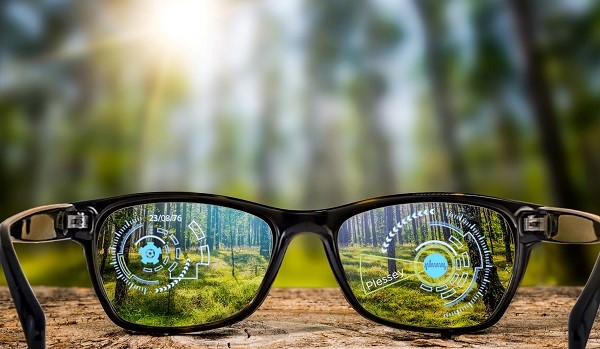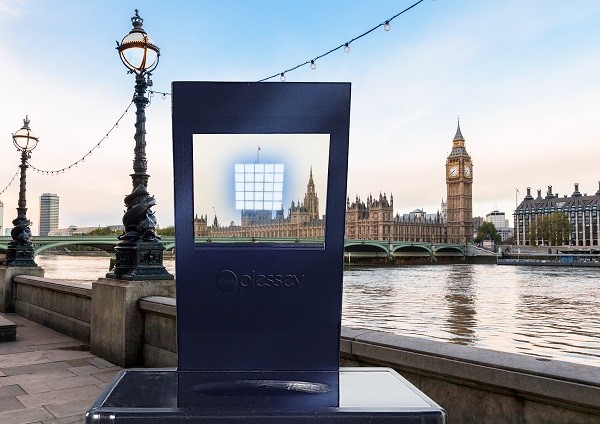2018 is a pivotal year for Mini/Micro LED development. UK-based Plessey Semiconductors in January announced its commitment to launch a Micro LED microdisplay featuring monolithic GaN-on-Silicon Micro LEDs. Following the announcement, LEDinside got in touch with Myles Blake, Marketing Director of Plessey Semiconductors, to learn more about its technology platform and product roadmap.
 |
|
Plessey’s Miro LED arrays feature high brightness that allows clear image projection under strong outdoor ambient light. (Image: Plessey Semiconductors) |
Plessey acquired GaN-on-Si growth technology from the University of Cambridge in 2012 and has been developing available 6- and 8-inch silicon LED products over the past five years. Compared with sapphire, silicon, with inherent heat dissipation capability, provides a far better thermal performance and lower the cost of lumens per die area for Micro LEDs. The non-transparent nature of silicon focuses the light output, further enabling simplification of optical systems. Also, using silicon substrates helps maintain lumens per watt while scaling up the die size. The three main unique selling propositions (USPs) of increased brightness providing better resolution, improved thermal capability and power efficiency around silicon has made GaN-on-silicon Plessey’s technology platform for the production of Micro LEDs, said Blake.
Having done extensive research on silicon, the company also acknowledges difficulties in the process of epitaxial growth on silicon, such as lattice mismatch between GaN and silicon, material cracks resulting from thermal mismatch, and poor yield for melt-back etching. However, Blake revealed the company tackled those challenges by growing GaN in over 100 controlled layers, including buffer layers, strain engineering layers, defect reduction layers, recovery layers, and finally active LED layers on the top under strict temperature controls.
In terms of Micro LED development, according to Blake, Plessey is currently working on two product families targeting applications including head-up displays (HUD), head-mounted displays (HMD), projectors and alike.
 |
|
Plessey’s first demo showcased in London (Image: Plessey Semiconductors)
|
Plessey developed Micro LED light engine Quanta-Brite using RGB Micro LED arrays covered with patented optics that removes the requirements of collimating and fly eye lens and prisms needed in devices using conventional illumination modules. When lighting up, the Micro LED module projects light into the field lens, illumination the DMD or LCoS display uniformly and more efficiently than current technology. The Quanta-Brite will soon be released, expected in the next few weeks, Blake confirmed.
He continued that this year the company will also unveil the Quanta-Ray, a Micro LED RGB microdisplay solution that is designed to replace digital micro-mirror device (DMD). A monochromatic model that features a pixel of 6.4µm and a pitch of 8µm in an array area of 3mm*3mm (approximately 100,000 pixels contained) will be first launched in June/July 2018. This will be promptly followed by a 0.7-inch full color Quanta-Ray with a pixel pitch of 16µm (960x540) in Q4 2018, followed by a 1.0-inch color version of 11.6µm (1920x1080) in Q2 2019. These innovations will be showcased respectively at the upcoming events including Display Week 2018 in Los Angeles, AR & VR World in London in June, AR /VR Global Summit in Vancouver in September and CES in January 2019, said the Marketing Director.
Talking about realizing the product roadmap, Blake explained that they have been investing their R&D efforts around three focuses. The company has successfully pushed down the size of pixels from 256µm to 1µm, devised backplanes able to address individual pixels, and developed solutions to prevent color crosstalk between RGB subpixels.
As for colorization, Blake shared with LEDinside that the company uses quantum dots to convert selected die regions of blue LED wafers into red and green LED dies. The technology enables LEDs of three colors all on a single wafer, which simplifies the transfer process. Simply by using wafer bonding, full color Micro LED arrays can be integrated with a CMOS backplane and later installed in a device.
Blake said the anticipation for Micro LED is growing strong. Plessey has built a solid technology foundation and is in a position to offer Micro LED products with a brightness 1,000 times higher than OLED, with a form factor as small as 1µm per pixel, and display resolution up to 1080p. “We expect our technologies to meet requirements of multiple applications. We provide both 6- and 8-inch monolithic wafers, so we are able to grow, for example, a smartphone or smartwatch Micro LED screen on one wafer. Also, as a semiconductor manufacturer, we can in the long run even embed devices such as video controllers in a backplane carrying Micro LEDs and make it a more desired multifunctional display,” concluded Blake.
(Myles Blake, Marketing Director of Plessey Semiconductors, was interviewed by Simon Yang, Max Chen, and Evangeline Huang. The article was written by Evangeline Huang, Editor, LEDinside)













